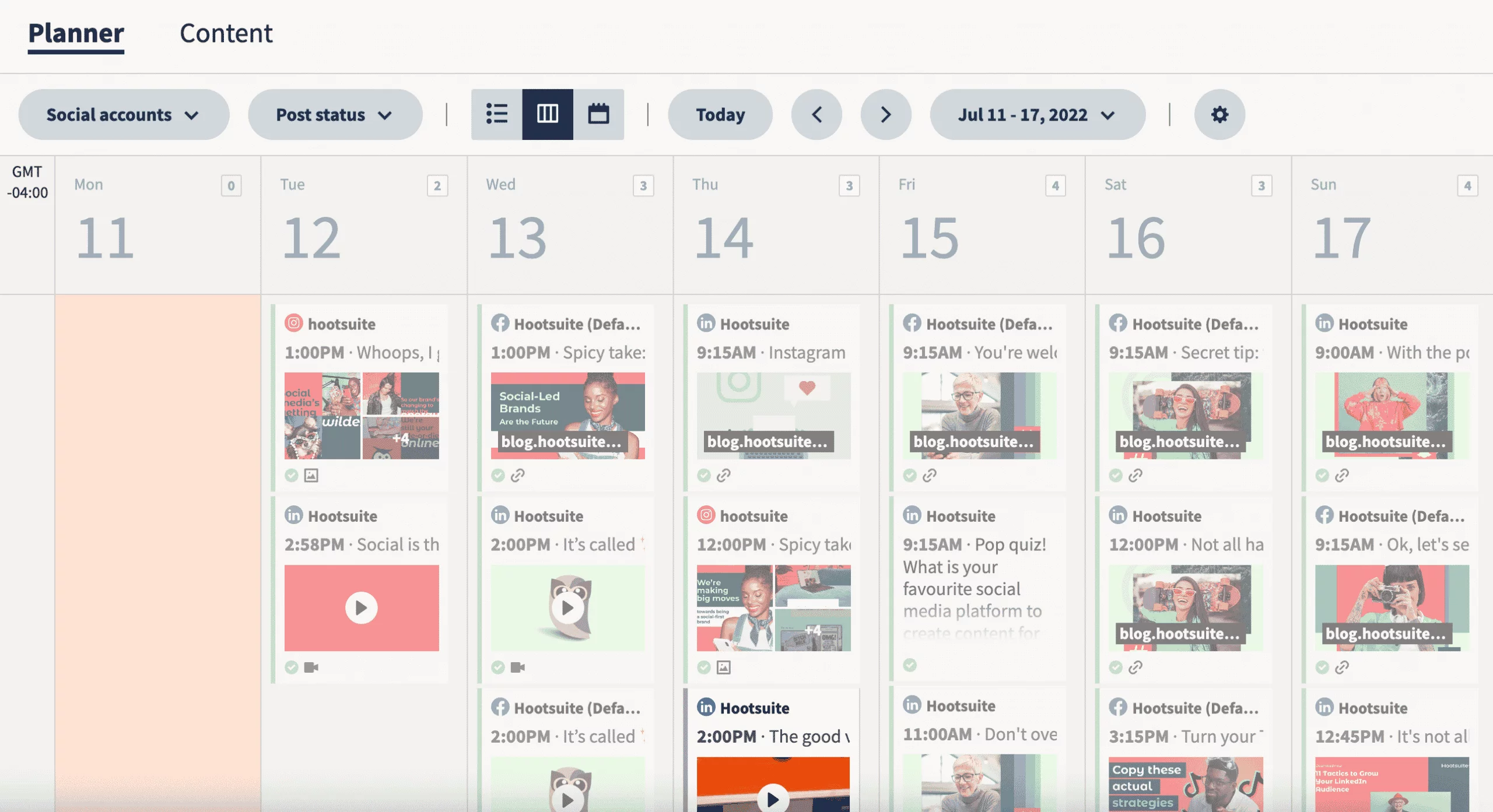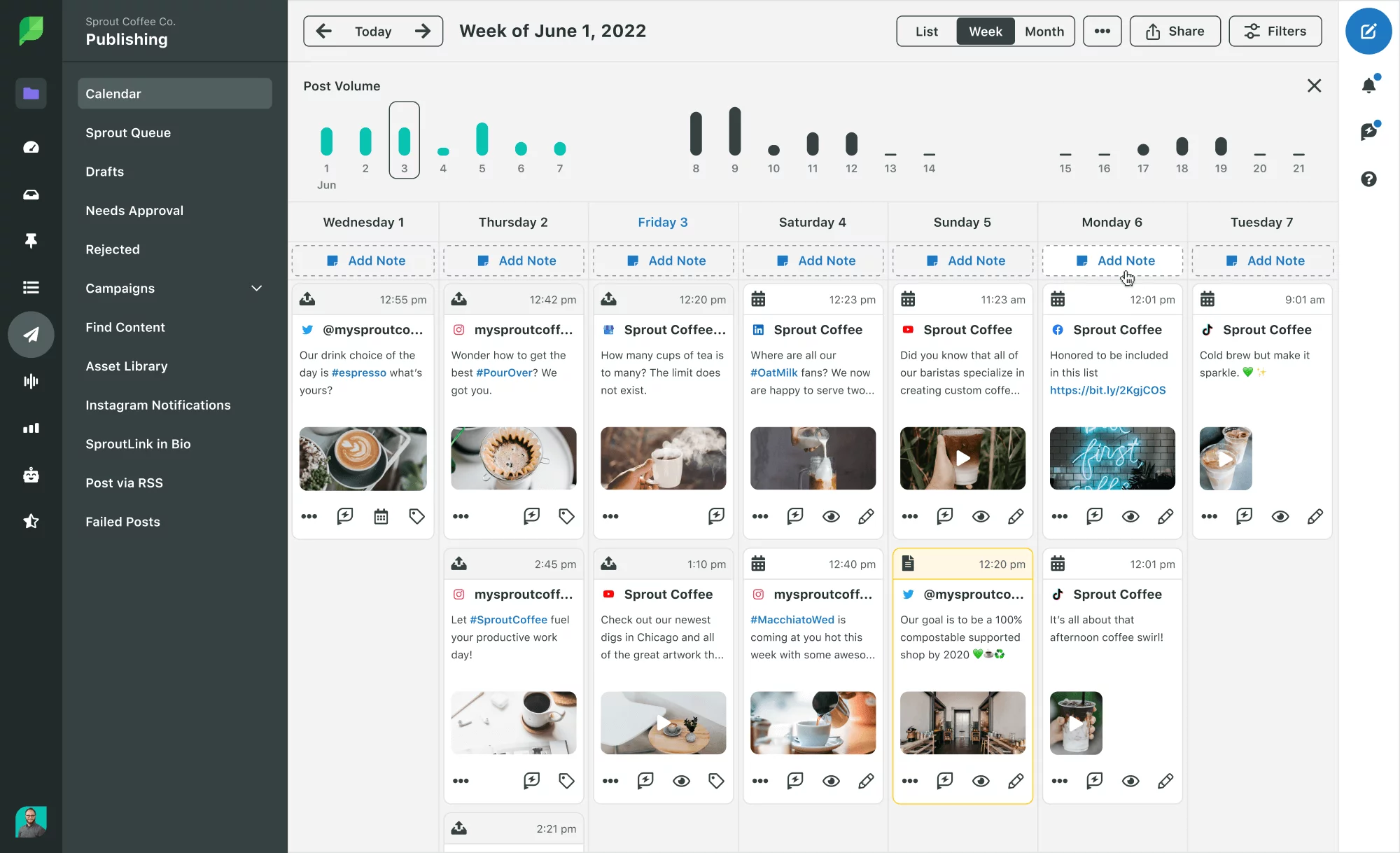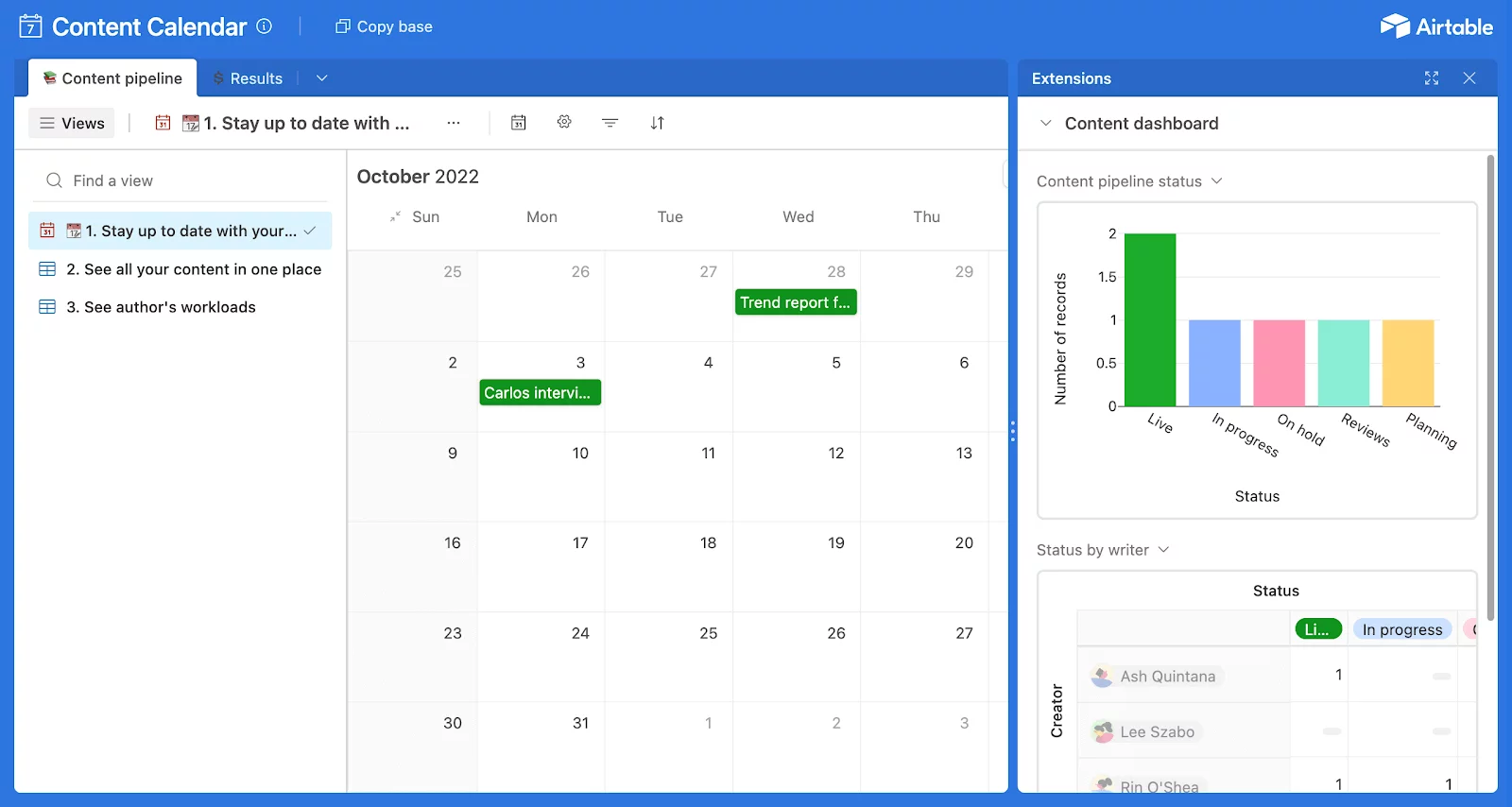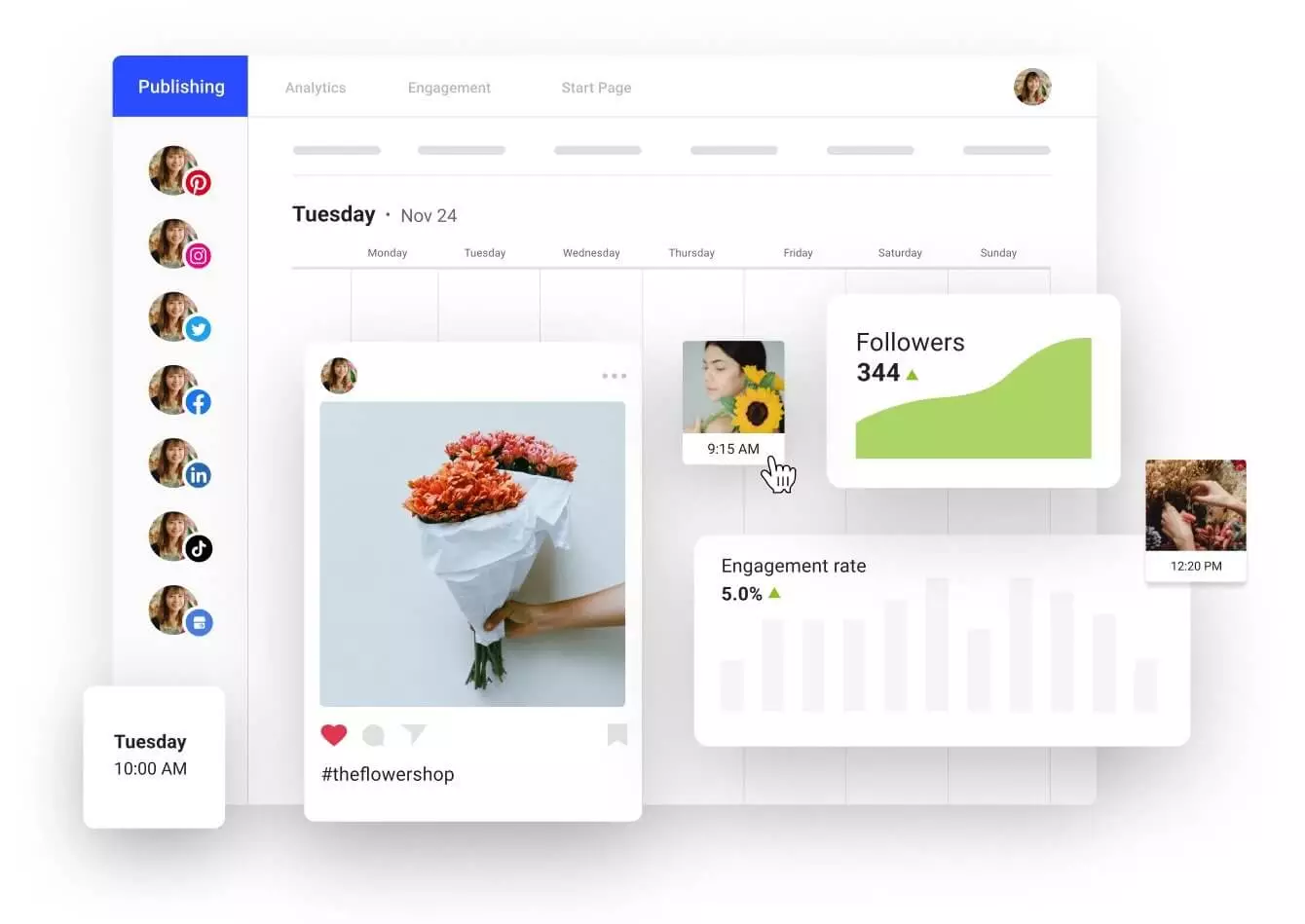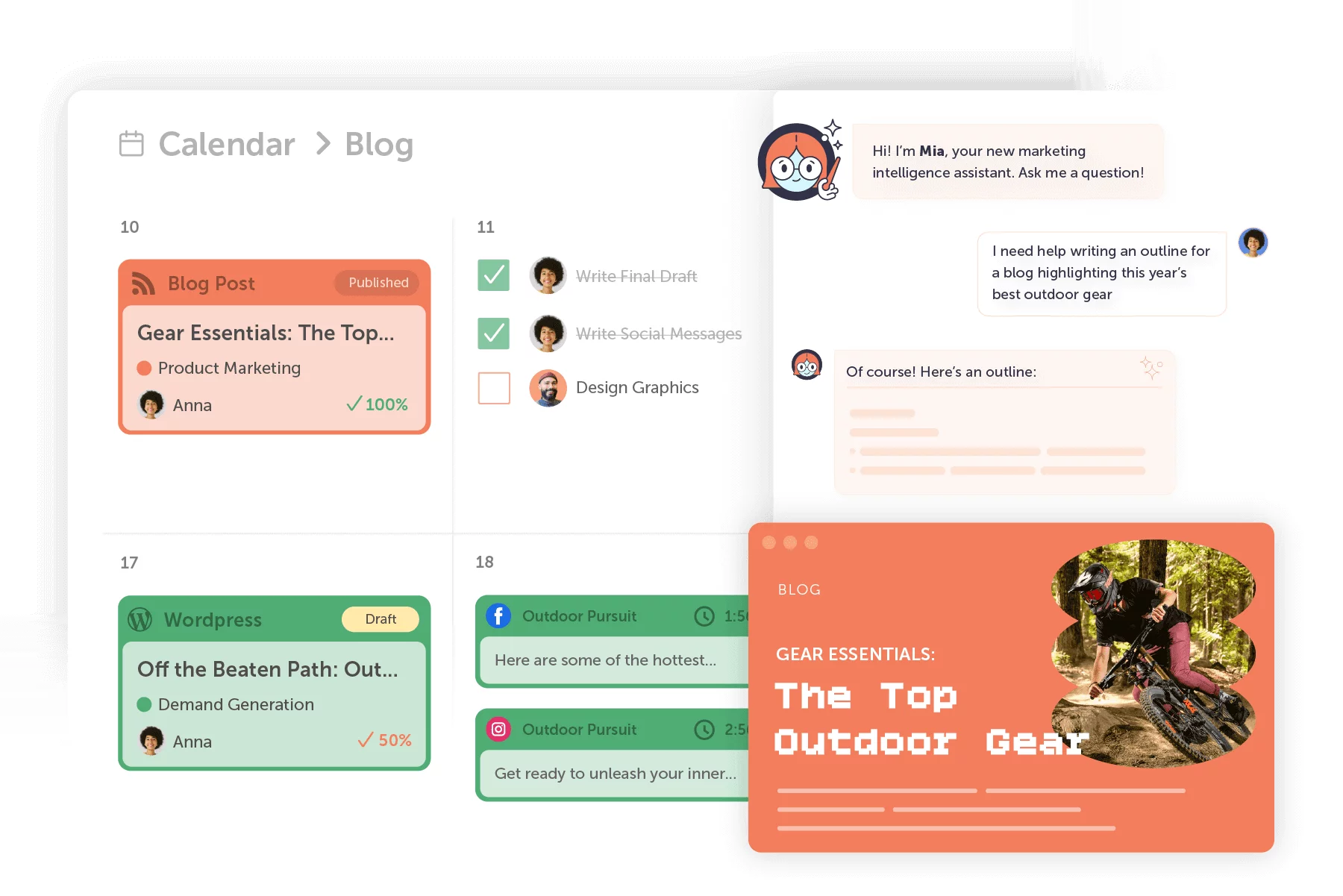Content calendar tools are an absolute must for marketing agencies juggling content for multiple clients. But how do you choose the one that fits your workflow and pleases your clients? Think about the awesome combo of content and social media calendar.
There’s no escaping some trial and error, but you can cut corners with my list of the tried and tested top nine content calendar tools! Read on for detailed reviews of the market’s most prominent content calendar software.
Best social media content calendar tools
Planable | Google Sheets | Notion | Hootsuite | Sprout Social | ClickUp | Airtable | Buffer | CoSchedule
It’s tough enough to schedule and approve content for one client. However, agencies must cater to several clients simultaneously and still leave space for creativity.
Here are my nine tested social media tools that can ease content planning and let you concentrate on things that matter.
1. Planable: best content calendar software for planning & approving
Planable is a robust social media management platform that gives you a top-notch calendar feature and much more.
It’s the ultimate content multitool for social media managers: you can work on any content, rock collaboration with colleagues, and get the green light from clients in the blink of an eye. No spreadsheets. No mess. No stress.
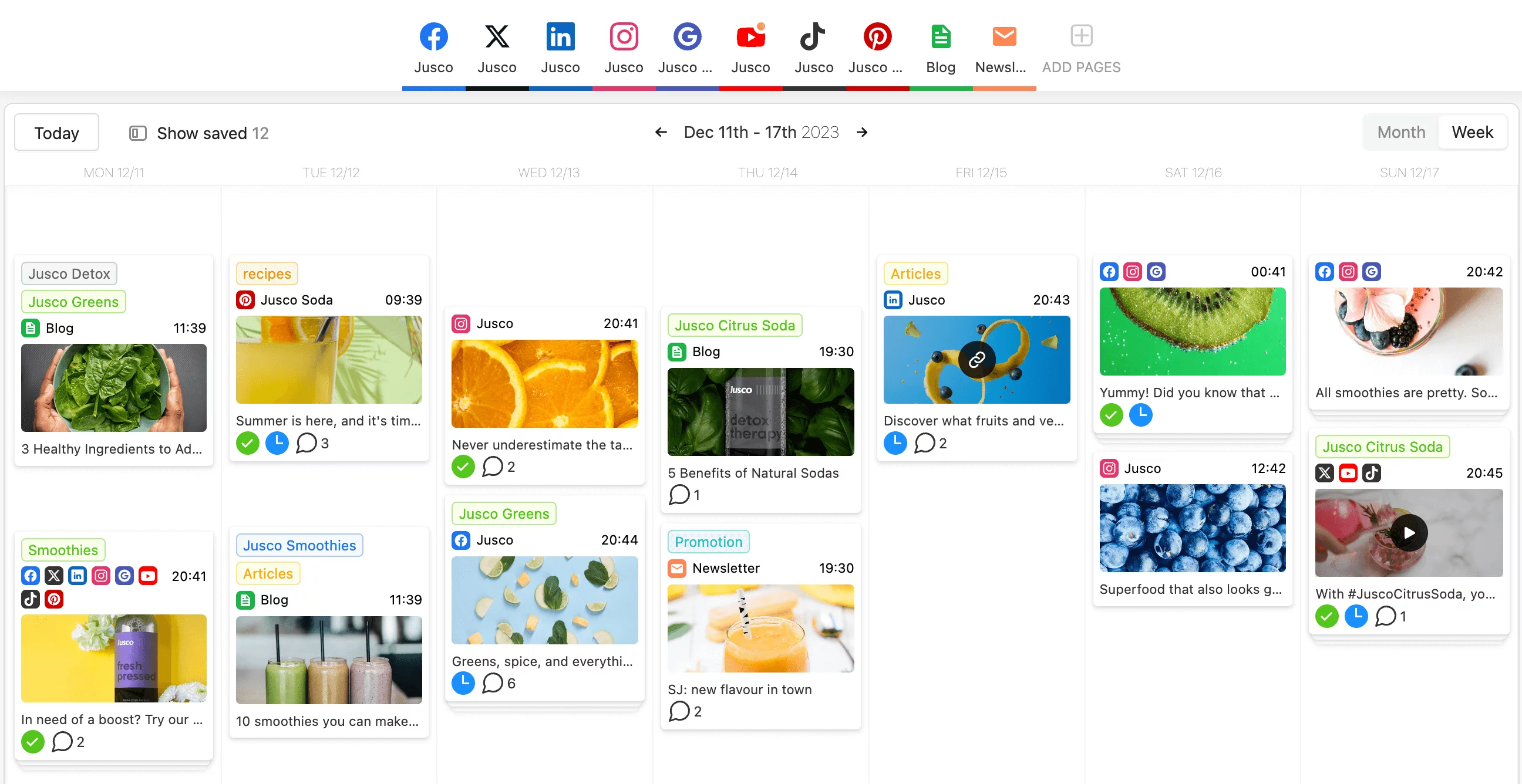
Planable’s content calendar with blogs and social media posts
With Planable’s workspaces, you can create separate ecosystems for each client and easily include them in the loop. Clients won’t ask you for a link to the content again — they have all the pieces of content right in the content calendar, ready to approve with one click.
The content calendar is simple and intuitive yet packed with features. Marketers can leverage four views: calendar, feed, list, and grid. Change of plans? Just drag and drop your scheduled content to another date. Multiple campaigns in action? Stamp custom labels on each post to divide them into categories.
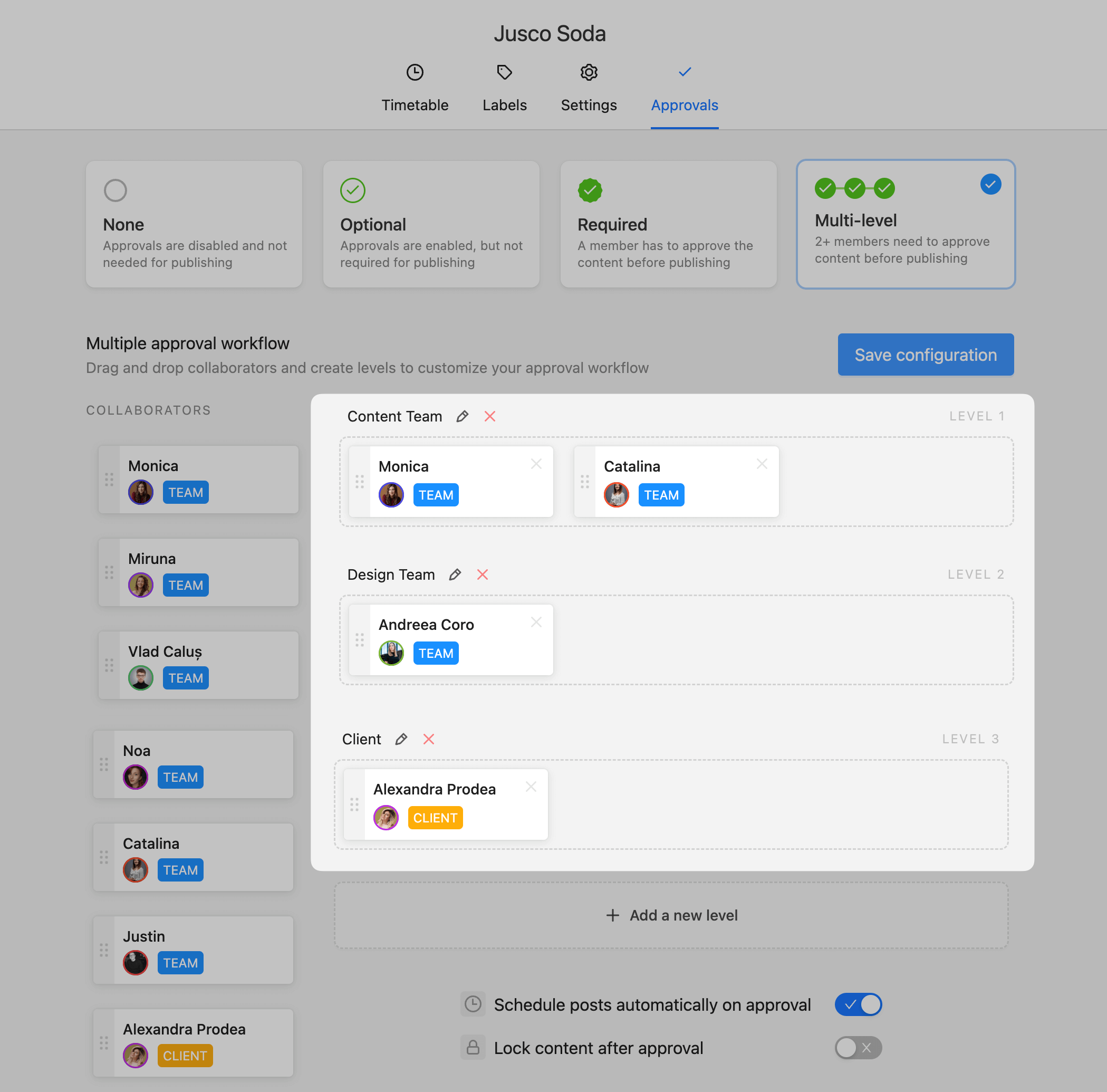
Multi-level approval workflow feature in Planable
Core features:
- Auto-publishing to major social media platforms. Planable can automatically publish your content to 8 social channels: Instagram, Facebook, X, LinkedIn, Pinterest, TikTok, YouTube, and Google My Business.
- Multi-level approval workflows. It’s a thing to die for in a marketing agency. Get the internal approval from the team first and then pass the polished version to the client. A couple of clicks instead of complicated spreadsheets for countless hours and tons of emails.
- Custom roles. Invite your internal and external collaborators to the workspace and set boundaries with custom roles and permissions.
- Ultimate collaboration. Planable is all about collaboration: you can leave in-context comments & suggestions, use internal notes, and create content together with your colleagues.
- Intuitive Analytics. Easily check out how your content performs on social media and create professional reports for clients or stakeholders.
Pricing: Planable has flexible pricing based on the feature set, number of workspaces, and users. After a free trial period, you can upgrade for $11/month per user, paid annually, or customize your price further based on your team’s requirements.
2. Google Sheets: the best free social media calendar tool
Good old Google Sheets is like training wheels in essential content planning. Available and familiar to anyone with a computer, it’s a popular choice for basic social media planning at marketing agencies.
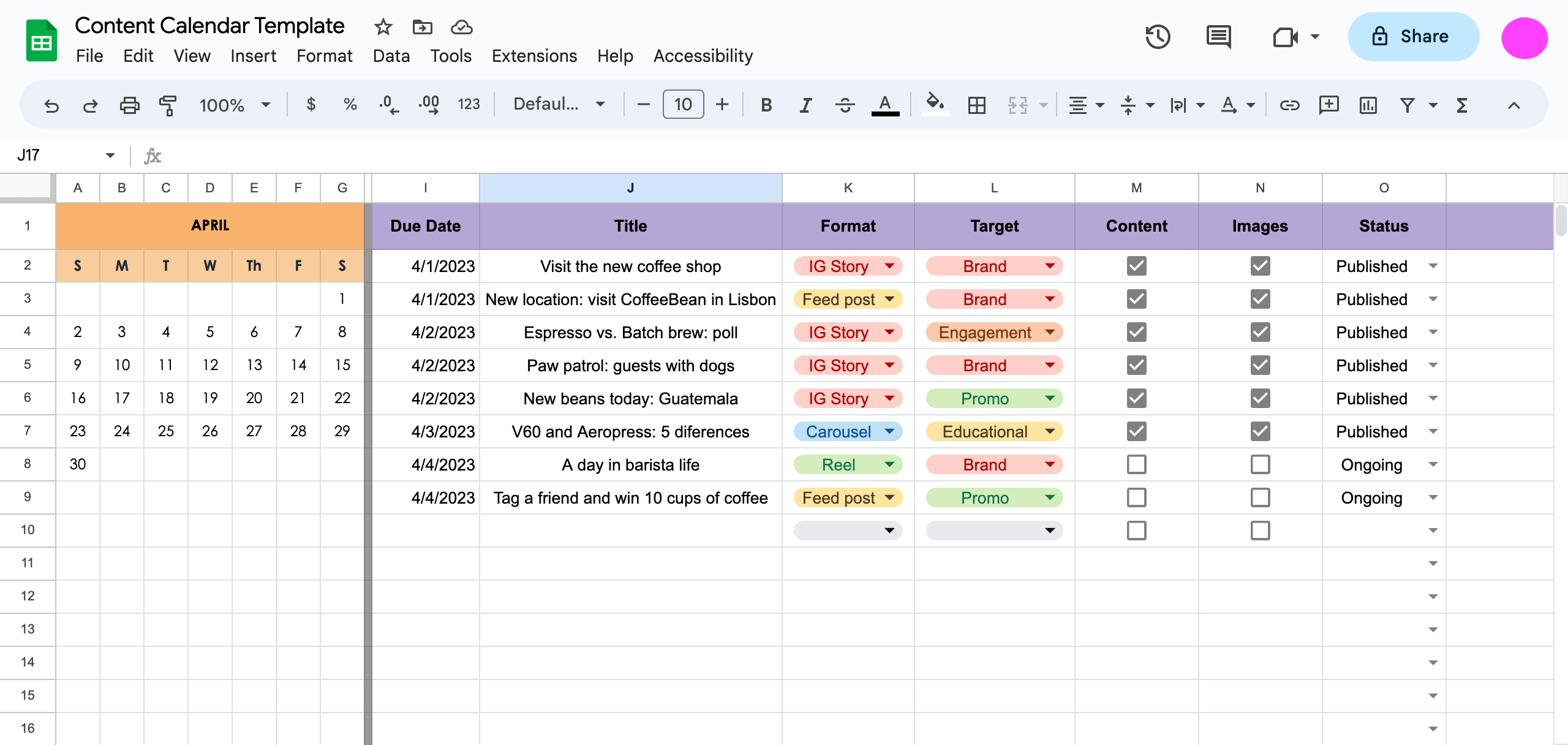
Don’t know where to start? It’s easy to find an excellent social media calendar template that you can repurpose — since Sheets are widespread, you can find all sorts of templates online. Customize them with tags, filters, and drop-down menus.
Core features:
- Affordable and accessible. Everybody knows Google Sheets: you, your teammates, your clients. No learning curve and no trouble aligning plans — you already have your social media content calendar tool pre-installed.
- Pro analysis tools. Similar to Excel, Sheets are mighty when it comes to calculations, formulas, and charts.
Downsides: Sheets is not a dedicated content management platform. Agencies can use it as a starting point in content planning, but it’s not a robust tool. As the agency grows, you might want to up your game with automation and platform previews, and Google Sheets can’t provide that.
However, if you never used social media calendars before and want to implement them into your workflow, Google Sheets is a decent free option.
Pricing: Google Sheets are free. If you’re a big agency in need of the whole GSuite, the Google Workspace price starts at $7.20/month per user.
3. Notion: the best social media calendar with task tracking
Notion is an excellent tool to streamline your social media efforts and build an efficient editorial calendar. Although it’s not tailored for content management specifically, it combines tracking tasks and planning content nicely.
Marketing teams use Notion’s collaboration tools to create smooth workflows and stay on track through the content creation process. Members of the workspace can tag each other in tasks, leave comments, and work together on brainstorming new social posts and other content pieces.
Core features:
- Tons of templates. From a simple editorial calendar to a full-scale content marketing task tracking and creation pipeline, Notion has it all. Just choose a free template that suits you the most and start working.
- Dedicated workspaces. As an agency, you have to manage multiple clients. In Notion, you can create separate workspaces to manage content calendars for each client and switch between them effortlessly.
Downsides: Notion remains a fancy version of Google Calendar combined with task tracking. No platform analytics or automated approval workflows — just a straightforward content calendar with basic workflows.
Pricing: Notion has a free version (which, sadly, won’t be enough for an agency) and three paid plans, starting at $10/month per user.
4. Hootsuite: best full-cycle content management software
Hootsuite is one of the packed social media management tools agencies use for full-cycle content management.
Besides a visual calendar, Hootsuite provides marketing teams with built-in analytics, direct social media publishing tools, social listening, and a centralized inbox. You can manage your client’s portfolio from one dashboard.
Many users mention bulk scheduling as one of their favorite features. Working with many clients, agencies manage enormous amounts of content, and bulk scheduling is the kind of social media automation that saves the day.
Core features:
- Auto publishing. Hootsuite supports direct publishing to major social media channels like Instagram, Facebook, LinkedIn, X, YouTube, Pinterest, and TikTok.
- Unified social inbox & social listening. All tags, mentions, and DMs gathered in one place. Social inbox helps marketing teams jump on the conversation faster and enhances clients’ social media presence by timely replies.
Downsides: Some social media marketers say Hootsuite’s interface is a bit outdated. Another thing to keep in mind is approval workflows — those are only included in the Enterprise plan.
Pricing: Hootsuite has three paid plans starting at $99/month.
5. Sprout Social: the best social media management tool for big budgets
If Hootsuite is a full package, Sprout Social is double that. It’s a super-packed content marketing platform jacked with features and add-ons.
Its social media scheduling tool allows you to plan and publish social posts to multiple social media accounts simultaneously — or tailor preferred timing for each network.
For publishing, Sprout Social supports Facebook, Instagram, LinkedIn, Pinterest, TikTok, X, and YouTube. You can schedule social media posts to go live automatically and move on to the next client.
Core features:
- In-depth analytics. Including the client’s channels overview, competitive analysis, and audience research — a perfect foundation for a successful social strategy.
- Visual social media calendar. Plan your social media campaigns or stand-alone posts in a shared content calendar tool. You can easily share it with your teammates and clients for approval.
Downsides: The biggest disadvantage of Sprout Social is the price: for such a multitool, you’ll pay at least $249/month — with five social accounts, no approvals, and competitive reports. But if you are a big agency with lots of clients and high stakes, consider using those 30 days of free trial period.
Pricing: as I said — ooofff. The cheapest plan is $249/month (with $199 per each extra user). Two other plans, Professional and Advanced, cost $399 and $499. Plus the Enterprise plan, which comes at a custom cost.
6. ClickUp: best project management tool with content calendars
One app to replace them all — that’s how ClickUp positions itself. This multi-purpose project management platform equips marketing teams with customizable task management, real-time communication, and many templates, including a social media calendar.
ClickUp helps agencies visualize projects, collaborate on assets, and speed up content creation. The ready-made task tracker has multiple views to keep tabs on your content strategy. The content calendar view clarifies the upcoming plans, and the timeline is great for identifying potential overlaps and bottlenecks.
Core features:
- Template library. ClickUp has a lot of templates to ease the setup for your social media marketing team. Workspaces, tasks, docs, calendar tools — choose what suits you and customize the rest in iterations.
- Proofing. ClickUp allows marketing teams to share in-context feedback in docs, PDFs, images, and videos to apply client’s changes faster.
Downsides: ClickUp is tailored for project management rather than for running social media platforms. You can’t schedule or publish your content and can’t gather analytics — but you can create a task to do so.
Pricing: ClickUp has a forever free version that may be enough for a small agency. Regarding the paid plans, the platform offers three, starting at $7/month per user. Quite reasonable, if you ask me.
7. Airtable: best for custom content calendar apps
Airtable is a low-code platform that helps you craft robust, tailor-made databases and applications that boost your marketing team’s essential content workflows. It can be just the social media calendar or a full-bodied project management platform tailored to your needs.
The platform is rich in creating custom workflows with automated trigger actions. You can automate your task management, content publishing, and approval requests so the social media team can spend more time creating content than doing routine stuff.
Core features:
- Insane customization. You practically build your social media content planner from scratch to fit your needs. After the base is ready, link it with third-party apps for more functionality — like your own custom-made content tool.
- Pre-configured apps. Airtable has several content and social media calendar templates you can use to start building your app. You can also leverage ready-made user interface designs to beautify your app.
If your agency has a specific content creation pipeline or other peculiarities in the workflow, a custom social media calendar solution from Airtable may just be your thing.
Downsides: With such a level of customization, Airtable is not an out-of-the-box solution. Initially, the app you’re building has no functionality. You can schedule content, but the app won’t automatically publish posts unless you plug in Zapier or another third-party tool.
Pricing: Airtable has a free version and three paid plans starting at $24/month.
8. Buffer: best basic content calendar with analytics
I like Buffer for being just enough. As a social media calendar, Buffer helps manage social media content from a single dashboard with a clear interface and straightforward calendar view. Nothing too KABOOM in Buffer — it’s your regular social media calendar tool with planning, scheduling, and analytics.
You can batch schedule posts for any major social media platform like Instagram, Facebook, X, LinkedIn, TikTok, and Pinterest through Buffer.
Social inbox is also in the picture — this allows you to manage all client mentions in the same content calendar software you use for scheduling.
Core features:
- Content insights. Such as the best time to publish, posting frequency, etc. Schedule posts for the highest engagement time slots that Buffer identifies based on your audience insights.
- Automated reports. Reports take a lot of time when you have multiple clients. Buffer will generate your custom reports automatically, so you don’t have to gather them every month manually.
Downsides: For some social platforms, Buffer comes with limits on the number of posts to be scheduled in advance, even on the paid plans. Also, Buffer’s analytics doesn’t track paid content results, which can be an issue if you boost a post and want to include cumulative analytics in your report.
Pricing: Buffer offers flexible billing based on the number of channels and feature set. The free plan includes a content calendar for three channels with auto-publishing. The platform also has a dedicated Agency plan that costs $120/month for a pack of 10 channels, analytics, and collab features.
9. CoSchedule: best content calendar for multimedia planning
CoSchedule is a content calendar software that includes social media, blog posts, media releases, and all things content marketing. Marketing can get messy, especially when you have multiple brands to manage, and CoSchedule gets it.
Using CoSchedule calendar tools, it’s easier to identify schedule gaps, stay consistent in messaging, and organize social media campaigns. The platform recently added auto-publishing to social media, including Facebook, Instagram, YouTube, LinkedIn, X, TikTok, and Pinterest.
Core features:
- Editorial calendar. Track all marketing efforts for a client in one place and easily change priorities through a drag-and-drop rescheduling tool.
- Analytics. CoSchedule provides enough analytics to demonstrate your results to customers and tune the strategy accordingly. Reports include engagement and campaign reports, and general social media profile analysis.
Downsides: The disadvantage users see in CoSchedule is the lack of collaboration options. In the Social Calendar plan, you can comment on tasks and content, but approval workflows are only included in CoSchedule’s Suite.
Pricing: CoSchedule has a free calendar, which is pretty but not enough for a marketing agency. Besides that, the platform offers a Social Calendar for $29/month per user and a Content Calendar for custom prices.
Social media calendar tools FAQs
What’s the best content calendar tool for 2024?
With Planable, you can create, collaborate on, schedule, and distribute your social media posts in the blink of an eye. Planable helps streamline your content efforts and makes maintaining a perfect social media posting schedule ABC-easy.
How do you grow your social media accounts in 2024?
Create content that is high-quality, relevant to your audience, and true to your brand. Leverage trends, such as authenticity and transparency, and stay flexible in your content strategy. And plan ahead. Consistency is key! Also, using a marketing calendar is a great way to keep everything in check.
How do you integrate a calendar into social media?
Use trial periods to find the most convenient form of social media calendar for your team. Utilize labels, create templates for your recurring tasks, and lay out your content strategy on a timeline. Schedule content in advance and keep your calendar updated to support your workflow.




